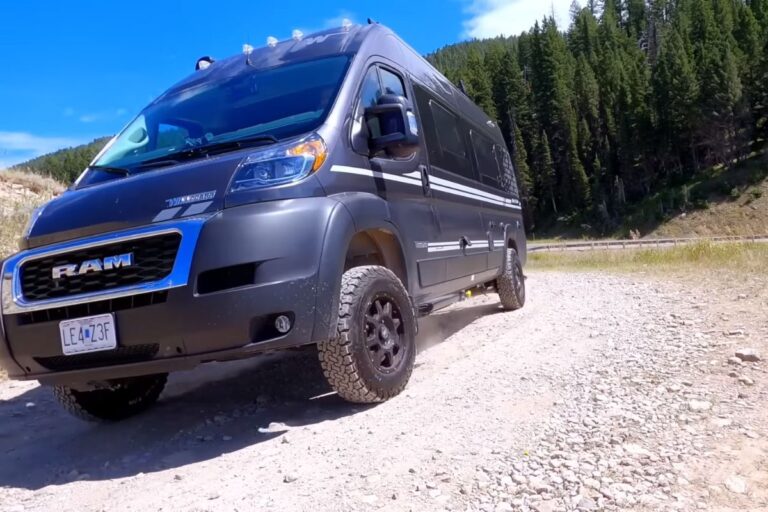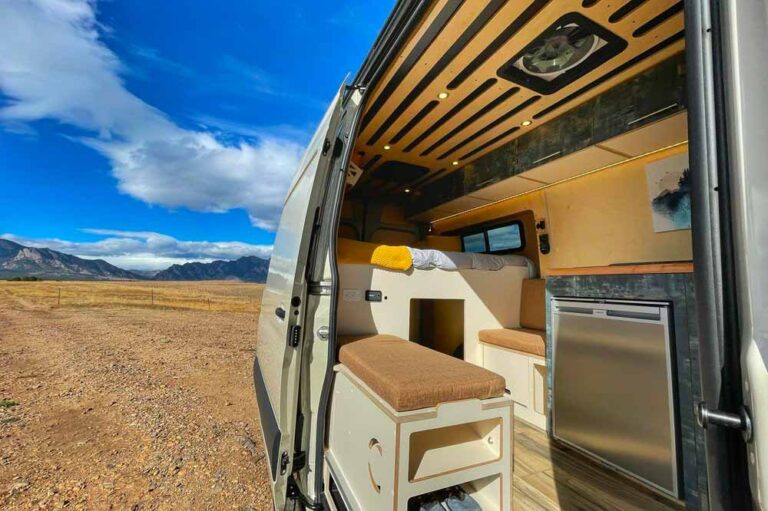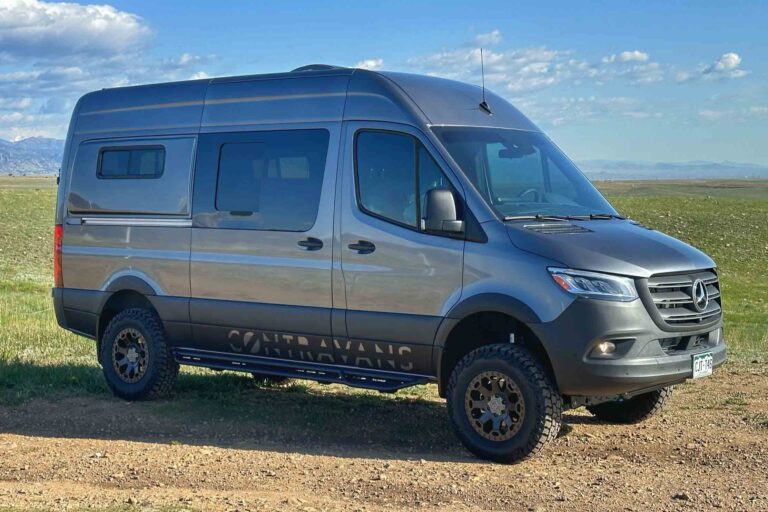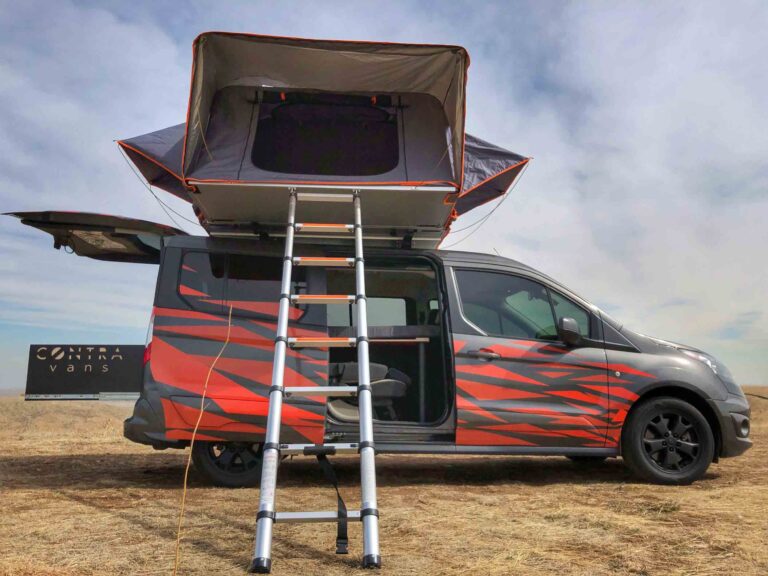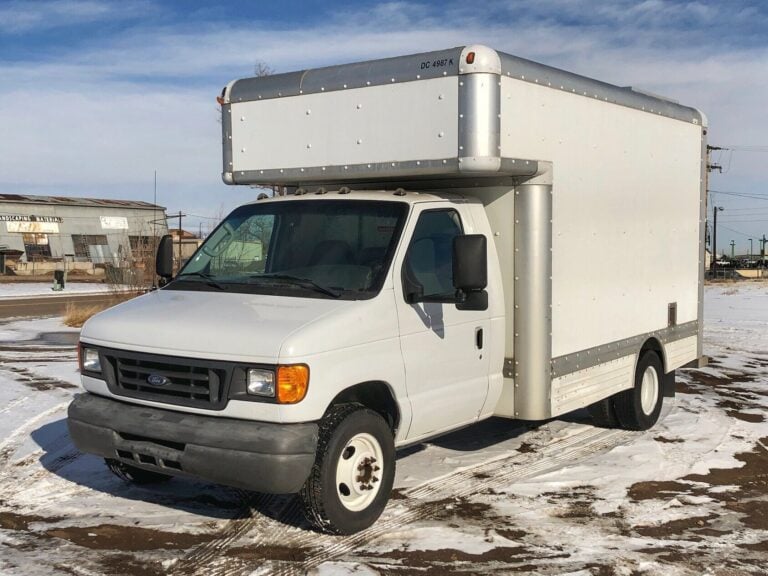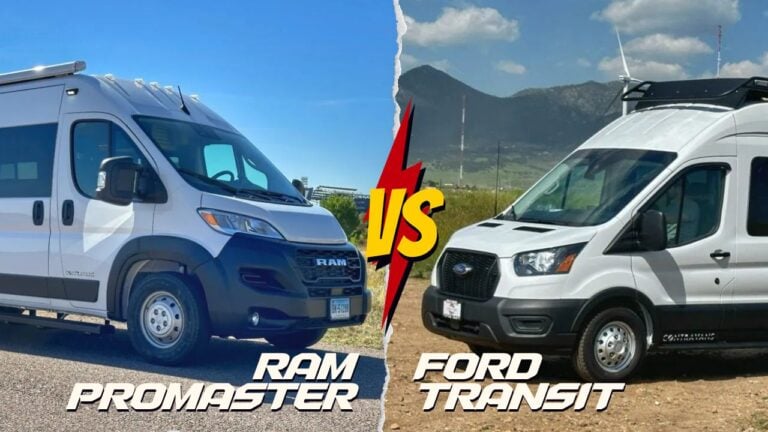Transit vs Sprinter | Which is the Best Campervan?
Transit vs Sprinter: Are you debating between these two iconic campervan choices?
When it comes to converting a van into a campervan, two names inevitably rise to the top: the Ford Transit and the Mercedes Sprinter. But which van offers the best canvas for your campervan dreams? Let’s navigate through this detailed comparison to help guide your choice.
Pro & Cons Chart | Mercedes Sprinter vs Ford Transit Campervan
| Mercedes Sprinter | Ford Transit | |
| Starting Price | $52,700 (standard roof van) | $44,455 (low roof van) |
| With Options Price | $85,000 (170″ high roof) | $65,000 (up to $75,000 with Trail Option) |
| Fuel Type | Diesel | Regular Gasoline |
| Engine | 2.0L Turbo Diesel or 2.0L Twin Turbo High Output Diesel (new in 2023) | 3.5L or 3.5L Twin Turbo Gas (Ecoboost) |
| Engine HP | 168 hp or 208 hp | 275 hp or 310 hp! |
| Engine Torque | 295 lb-ft or 332 lb-ft | 262 lb-ft or 410lb-ft |
| Drivetrain | 2WD Standard, AWD Available | 2WD Standard, AWD Available |
| Transmission | 9-speed Automatic | 10-speed Automatic |
| Aftermarket Accessory Options | Extensive Options | Fewer Options, but Expanding Greatly |
| Fuel Efficiency (city) | 14-18 mpg (varies by model and drivetrain) | 13-15 mpg (varies by model and drivetrain) |
| Fuel Efficiency (Highway) | 16-20 mpg (varies by model and drivetrain) | 16-19 mpg (varies by model and drivetrain) |
| Drive Feel | Smooth, Ergonomic, Precise | Responsive, Simple, Easy-handling |
| Reliability (Engine Life) | 300K-400K miles | 200K-300K miles |
| Standard Warranty | 3 years or 36,000 miles | 3 years or 36,000 miles |
| Maintenance Costs | $10,340 / 5 year average | $5625 / 5 year average |


Why the Mercedes Sprinter is better than the Ford Transit for a Campervan Conversion?
The Mercedes Sprinter epitomizes luxury and quality in vans. It’s equipped with top safety features like brake assist and lane-keeping. Its spacious interior is versatile for customization, supported by a large community for parts and add-ons. Additionally, its high resale value and longer engine life underscores its enduring appeal.
Why the Ford Transit is better than the Mercedes Sprinter for a Campervan Conversion?
The Ford Transit is highly valued for its safety, practicality, and affordability; ideal for van life newcomers. Its drive feels more like an SUV, making it very user-friendly less intimidating to drive. Due to its popularity, parts are cheaper and more accessible. The new Transit Trail option offers larger tires, more ground clearance and a more aggressive stance, similar to that of the Mercedes Sprinter.
Sprinter vs Transit Price Difference
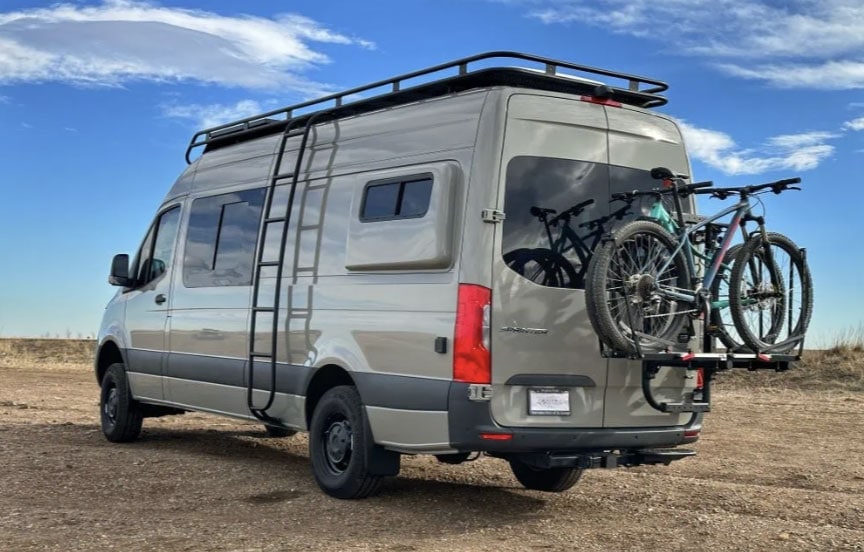
When diving into the campervan market, both the Mercedes Benz Sprinter and the Ford Transit rise as top contenders. A primary difference between the two often boils down to the price. Let’s dissect the price tags of these two popular vehicles.
Base Model Prices
Mercedes Benz Sprinter Prices:
The Sprinter starts with an edge on the pricier side. Its base model, a 144″ Standard Roof is tagged at $52,700. While it might seem more expensive at first glance, this price reflects its robust diesel engine which can potentially take the Sprinter beyond the 300,000-mile mark with regular maintenance. On the other side of the spectrum, Ford Transit might find it challenging to match this longevity.
Ford Transit Prices:
The 2023 Ford Transit is slightly kinder to your pocket at the onset, beginning at $44,455 for a 148″ Low Roof. When you peek at the used vehicle market, a 2018 Long-XL model of the Ford Transit mirrors the pricing of a Mercedes Benz Sprinter of the same age, with both hovering in the $40k range.
Van With Options Prices

Mercedes Benz Sprinter:
If you’re looking to splurge on features, the Sprinter’s price can rise significantly. A fully loaded 2023 Sprinter, incorporating all desired features, can shoot up to around $75,000 MSRP for a 144″ High Roof. A 170″ High Roof Extended will cost as much as $85,000 MSRP. Most folks opt for a High Roof as a starting point for their campervan, so you should expect to spend around $65,000-$70,000 MSRP minimum for a new AWD Sprinter.
Ford Transit:
On the other hand, a fully loaded 2023 Ford Transit, specifically the 148″ High Roof Long with a sprinkle of upgrades, fetches a price of around $65,000 MSRP. The new for 2023 Transit Trail Package adds a cool $12,600 to the price tag. That’s a lot for a 2″ lift, wheels & tires, and some plastic trim. However, many folks find value in getting the lift from the factory so it’s included in the warranty. High Roof Extended Transit Trails with all of the options come in around $75,000 MSRP.
Fuel Efficiency Ford Transit vs Mercedes Sprinter
When it comes to campervan adventures, fuel efficiency is key. Not only does it affect your travel range but also your pocket. Here’s a side-by-side comparison of the Ford Transit vs the Mercedes Sprinter to help you understand their fuel performance.
Gas vs Diesel
Ford Transit (Gasoline Engine):
- City Mileage: 13-15 mpg
- Highway Mileage: 16-19 mpg
- Combined: 17 mpg (rear-wheel-drive) & 15 mpg (all-wheel-drive)
- Tank Capacity: 25 gallons. We always recommend opting for the 31-gallon extended-range gas tank.
- Range on Full Tank: 350 to 475 miles (varies based on conditions and load)
Mercedes Sprinter (Diesel Engine):
- City Mileage: 14-18 mpg
- Highway Mileage: 16-20 mpg
- Combined: 18 mpg
- Tank Capacity: 25 gallons Ask us about installing a 45-gallon extended-range fuel tank!
- Range on Full Tank: 462 to 528 miles (subject to conditions and load)
In summary, while the Ford Transit offers the convenience of gasoline and a slightly larger tank capacity, the Mercedes Sprinter outperforms in fuel efficiency, giving you more miles per gallon, especially on long highway stretches. Initial cost, fuel prices, and diesel maintenance costs put the Ford Transit Ecoboost engine in the lead when it comes to overall cost to operate. The additional power of the Ecoboost vs. the Mercedes diesel is also quite significant, especially when climbing up the mountains on your way to the next ski trip!
Dimensions for Campervan Conversion – Transit vs Sprinter

For a successful campervan conversion, efficiently using the interior space and knowing the dimensions of your van is paramount. The dimensions of the van define the living space, storage capacity, and maneuverability. Let’s delve into the distinct dimensions of both the Ford Transit and Mercedes Sprinter.
Key Dimensions
Mercedes Benz Sprinter (2023 Model):
- Wheelbase: 144” (most common and iconic) and 170”.
- Roof Height: The high roof 4×4 or AWD is about 9’5” tall before adding rooftop accessories.
- Legroom: 38.9” in the front.
- Driver Headroom: About 47.3”.
Ford Transit:
- Wheelbase: 130” (low and medium roof models) and 148” (low, medium, & high roof models).
- Roof Height: Low Roof ~6’11”, Medium Roof ~8’3″, High Roof ~9’1”, Transit Trail package adds ~3″.
- Legroom: A roomier 41.3” across all models.
- Driver Headroom: A maximum of 56.6”.
Interior Space
Exterior height doesn’t always tell the whole story. The space inside can differ, especially when considering floor-to-ceiling height for a campervan conversion. Here’s a comparison:
| Van Type | Standard / Low Roof Height | Inside Space (before conversion) | High Roof Height | Inside Space (before conversion) |
|---|---|---|---|---|
| Sprinter | 96” (8’0”) | 65” (5’5”) | 114” (9’5”) | 78” (6’5”) |
| Transit | 83” (6’11”) | 57” (4’9”) | 110” (9’1”) to 113″ (9’4″) | 81” (6’9”) |
This comparison shows that while Sprinter and Transit might have similar exterior heights, the actual usable space inside can vary. Neither of the low roof models will allow you to stand up inside. That’s why most folks that opt for a low roof will add a pop top. The Transit High Roof has a lower ride height, so it offers more room inside even if its exterior height is about the same as the Sprinter’s.
In short, if you’re considering a van for a campervan conversion, look beyond just the exterior dimensions. The interior space, which directly impacts your living area, can differ significantly between models.
Reliability (Lifespan) Transit vs Sprinter
Reliability is paramount when investing in a van, especially for those planning extensive travels, remote work, or full-time living in their campervan conversion. Here’s a more in-depth look at how the Sprinter vs Transit compare:
Mercedes Sprinter:
- Lifespan: Mercedes Sprinter vans are known for their durability and longevity, especially with their diesel engines. With regular and proper maintenance, these vans can easily surpass 300,000 miles, and some Sprinters have even been reported to reach 500,000 miles or more without requiring any major rebuilds.
- Maintenance: While Sprinters can last longer, they will require specific dealer-only parts or specialized service when needing repairs. It’s essential to consider this aspect when looking at long-term costs as well as potential downtime during repairs.
Ford Transit:
- Lifespan: The Ford Transit has a mileage expectancy of around 150,000-200,000 miles. With proper maintenance and care, it can last to 300,000 miles or even more. This doesn’t mean the Transit lacks in build quality; it’s a testament to the robustness of modern vehicles. Some Transit owners, especially those who prioritize routine maintenance, have found their vans pushing past this milestone.
- Maintenance: Ford has a widespread network of dealers and service centers, making it easier to find parts and service, especially compared to Mercedes. Basic maintenance (brakes, oil changes, tune-ups) will be cheaper when compared with the Sprinter van.
In conclusion, while the Sprinter has an edge in longevity, both vans can offer extended lifespans when treated with care. Individual usage patterns, driving conditions, and adherence to maintenance schedules will play a significant role in the actual mileage one might get from either vehicle. Overall cost of ownership will be higher if you choose to step into a Mercedes.
Maintenance Costs Transit vs Sprinter

When comparing the projected maintenance and repair costs between the Transit vs Sprinter over a span of 5 years and 100,000 miles, the following data emerges based on manufacturer projections:
Mercedes Sprinter:
- Projected Costs: The Sprinter’s maintenance and repair costs are estimated at $10,340 for a 5-year/100k mile prepaid maintenance (ppm) and extended warranty plan.
- Service Intervals: With its diesel engine, the Sprinter needs servicing every 20,000 miles.
Ford Transit:
- Projected Costs: The Transit comes in at a more affordable $5,625 for its 5-year/100k mile prepaid maintenance (ppm) and extended warranty. This cost also accounts for the full synthetic oil option.
- Service Intervals: With the synthetic oil option, the Transit requires servicing every 10,000 miles.
In essence, the Sprinter’s maintenance costs are nearly double compared to the Transit for the same period and mileage.
Engine Performance Transit vs Sprinter
The Ford Transit vs Mercedes Sprinter: Both cater to different preferences when it comes to engine performance. The Transit, with its two engine options, presents a potent choice for those seeking more horsepower and torque. The base 3.5-liter V-6 engine offers 275 horsepower and 262 lb-ft of torque, while the turbocharged Ecoboost variant steps it up with 310 horsepower and 410 lb-ft of torque. Paired with a 10-speed automatic transmission is second to none and provides smooth shifting and handling across various terrains.
On the other hand, the Mercedes Sprinter serves as a robust contender for those valuing diesel efficiency and off-road prowess. Its standard 2.0-liter I4 turbo diesel engine delivers 168 horsepower. The high-output twin 2.0-liter I4 twin turbo diesel engine produces 208 horsepower and 332 lb-ft of torque. New for 2023, these diesel engines have replaced the old 3.0-liter V6 turbo diesel. The twin turbo design of the high-output diesel engine has all but eliminated the turbo lag that plagued the older V6 engine. The 2023 model further impresses with a new all-wheel-drive system and 9-speed transmission. The upgraded engine and drivetrain far outperform the prior versions in the Mercedes Sprinter. The AWD models are even slightly taller than the 4×4 versions that they replaced!
In summary, if raw power and higher torque are your priorities, the Ford Transit Ecoboost engine emerges as the better choice. However, for those seeking diesel efficiency and enhanced off-road performance, the Mercedes Sprinter holds a compelling edge due to higher ground clearance and more available aftermarket suspension modifications.
Most Common Problems Ford Transit vs Mercedes Sprinter

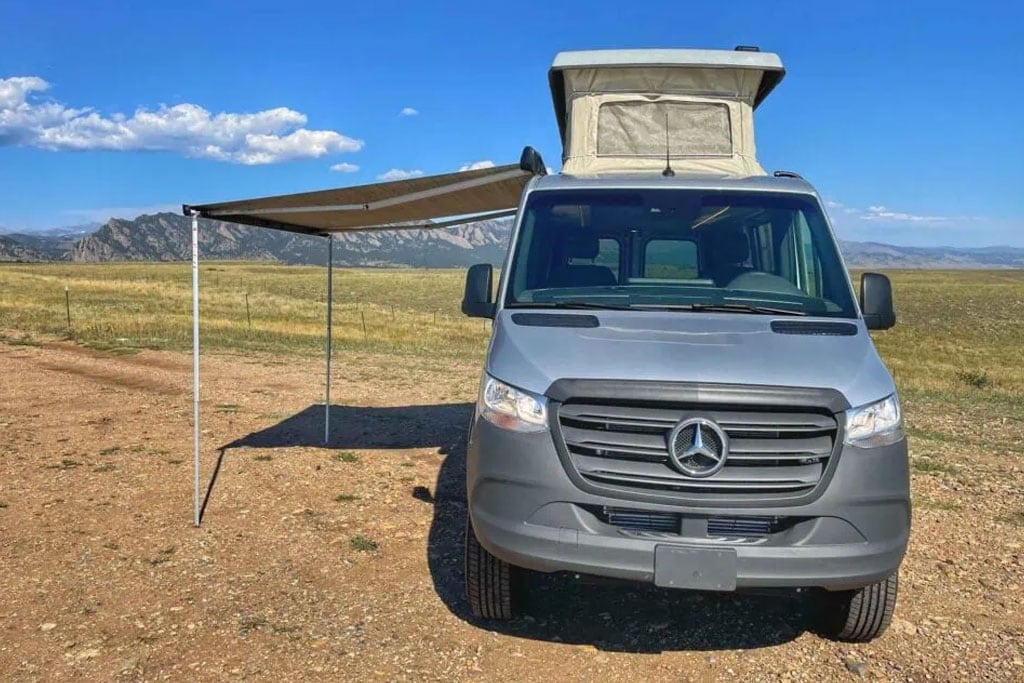
While both the Ford Transit and Mercedes Sprinter are popular choices for various uses, they each come with their own set of commonly reported issues. Understanding these problems can help potential owners make an informed decision.
Mercedes Sprinter Most Common Problems
- Diesel Particulate Filter (DPF) Issues: Sprinters with diesel engines may face clogging in the DPF, which could block the exhaust and potentially cause a shutdown. This is more prevalent in older diesel models.
- Oil Leaks: Sprinter vans often report oil leaks, typically from the oil cooler gasket. Although this is a direct fix, prompt attention is crucial to prevent additional issues.
- Engine Countdown: In some Sprinter models, a countdown meter on the dashboard indicates the number of engine starts remaining before a problem stops the van from operating.
Ford Transit Most Common Problems
- Recalls: Several recalls have been noted for the Ford Transits, including defects causing potential rollaways when parked or unexpected stalls. Checking for model-specific recalls is essential.
- Roof Leaks: Some Transit owners have reported issues with roof leaks, either due to manufacturing flaws or external roof damage.
It’s worth noting that while these problems have been identified by numerous users, not every vehicle will experience them. Regular maintenance and early attention to any problems can aid in extending the life of both vehicles.
Cost to Convert into a Campervan Ford Transit vs Mercedes Sprinter
When considering the conversion of a standard Transit vs Sprinter van into a road-ready campervan, the costs can vary based on the specifications, amenities, and personal preferences. Both the Ford Transit and the Mercedes Sprinter conversions start at a base price of $45,000. While the initial van price is similar for both models, the magic truly begins during the conversion process.
On average, converting either a Ford Transit or a Mercedes Sprinter into a fully-equipped campervan will cost around $60,000, depending on the accessories and customizations you opt for. This includes installations like bedding solutions, kitchenettes, storage units, electrical work for lighting, and device charging. Some may choose more luxurious finishes, additional amenities, suspension upgrades, and exterior add-ons like roof racks or rear door bike racks which can adjust this average cost.
For a more detailed breakdown of conversion costs and to explore the diverse options available, check out Contravans Campervan Conversions.
Campervan Examples by Contravans



For those keen on visual inspiration or looking to gauge the potential of both the Ford Transit and Mercedes Sprinter as campervan conversions, Contravans offers an extensive gallery. This gallery showcases many different conversion designs and their associated costs.
Explore our array of Ford Transit and Mercedes Sprinter campervan examples in our Contravans Photo Gallery.
FAQs – Mercedes Sprinter vs Ford Transit
When evaluating the Transit vs Sprinter for campervan conversions, potential buyers and enthusiasts often have a series of questions. Let’s address some of the most frequently asked questions about these two popular van models.
What are other Campervan Options to Consider?
Beyond the Mercedes Sprinter and Ford Transit, there are several other vehicles that enthusiasts often consider for campervan conversions. Some notable options include the RAM Promaster, Chevy Express, Volkswagen Transporter, and Nissan NV.
Each of these vehicles has its own set of advantages, ranging from size and configuration options to affordability and brand reputation. It’s essential to assess individual needs, budget, and desired features before settling on a specific model.
Is the Mercedes Sprinter or Ford Transit Bigger?
The 148″ Ford Transit and 144″ Mercedes Sprinter offer essentially the same amount of interior space for a campervan conversion. The 148″ Ford Transit Extended and 170″ Mercedes Sprinter are also similar in size. If you’re looking for the longest, largest van on the road, the Mercedes Sprinter offers the largest configuration with its 170″ extended wheelbase option.
In terms of exterior height, both vans are fairly comparable. However, the crucial measurement to consider is the interior height where Ford wins out by several valuable inches of headroom. Our taller customers often prefer the Ford Transit for this reason.
Which has a Better Towing Capacity?
Towing capacity can vary based on the specific model and configuration of the vehicle. Generally, both the Mercedes Sprinter and Ford Transit offer competitive towing capacities suitable for most campervan needs. It’s essential to check the exact model and its specifications, but on average, both vehicles can comfortably tow between 5,000 to 7,500 pounds. If towing is a priority, it’s recommended to consult with the respective dealerships for precise figures.
Transit vs Sprinter: 4×4 vs AWD
Both the Ford Transit and Mercedes Sprinter offer advanced driveline systems suitable for varied terrains. Both models come standard in rear-wheel-drive and both have an all-wheel-drive (AWD) option. AWD highly sought after for additional confidence with off-road adventures and challenging road conditions, especially during ski season.
Mercedes 4×4 drivetrain was discontinued after the 2022 model year.
Ford Transit and Mercedes Sprinter Campervans For Sale

For those keen on exploring campervan options or purchasing a ready-to-go model, Contravans offers a selection of both Ford Transit and Mercedes Sprinter vehicles.
Conclusion: Which is the Best Campervan? Mercedes Sprinter vs Ford Transit
Choosing between the Mercedes Sprinter and the Ford Transit ultimately comes down to personal preference and intended use.
The Mercedes Sprinter is known for its luxurious feel, extended configurations, and sleek design. It boasts a slightly longer lifespan and is ideal for those wanting a top-tier van experience with a touch of elegance. The option for AWD and corresponding ground clearance makes it the most suited for adventurers aiming to tackle off-road terrains.
On the other hand, the Ford Transit has a reputation for being durable, reliable, and slightly more maneuverable in urban settings. Its cost-effective maintenance, nimble driving experience, and robust eco-boost engine can appeal to many campervan enthusiasts. Minor aftermarket suspension upgrades can provide most campervan owners with sufficient ground clearance for the majority of washboard roads you may encounter.
Ultimately, the best campervan is the one that aligns with your needs, budget, and travel goals. Whether you’re drawn to the luxury of the Sprinter or the reliability of the Transit, both vans have proven themselves worthy companions on the open road.
Get A Free Van Conversion Quote
Ready to make your campervan dream a reality? Get a free quote tailored to your needs. Contact Contravans now and start your journey!
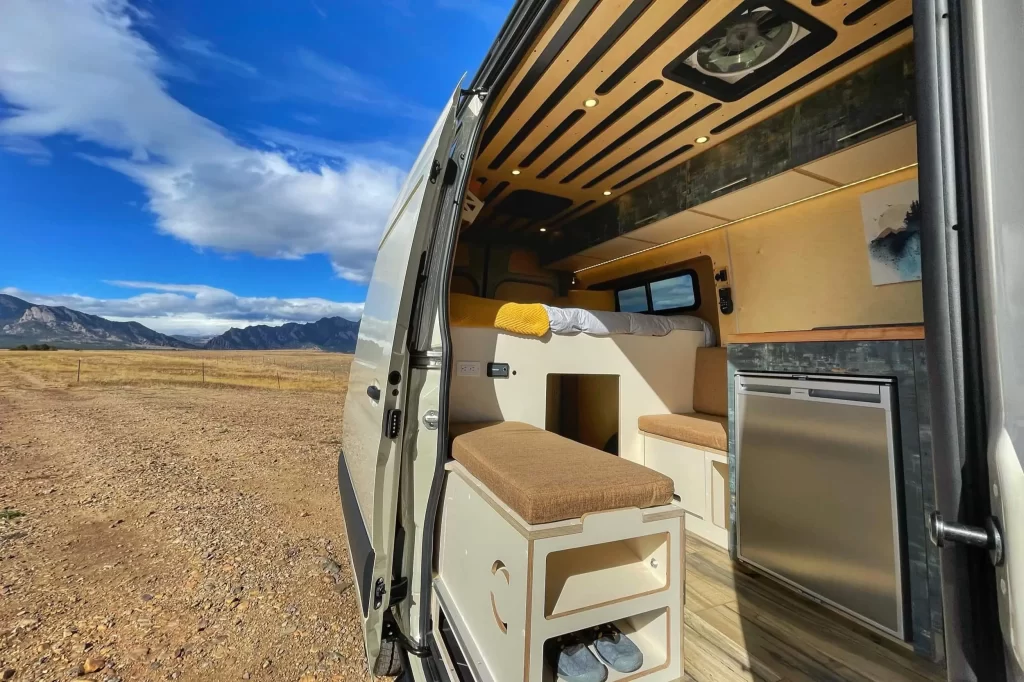
Compare other vans that might be a good fit for your purpose with our full guide: What is the Best Van to Convert to a Camper Van?
You might also be interested in:
Ford Transit Lift Kit: A Complete Guide


